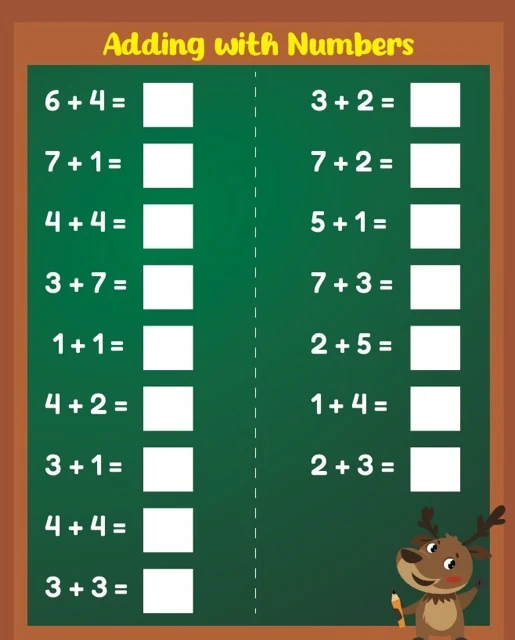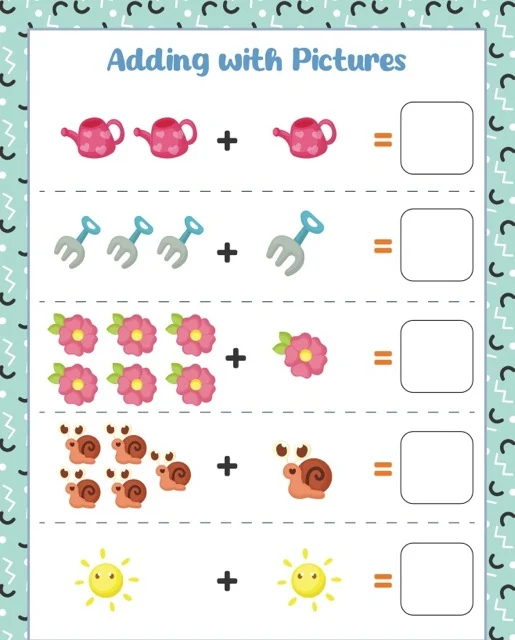Mastering Addition: A Comprehensive Guide
The provided text comprises several resources focused on teaching fundamental addition skills. Materials include a FAQ, a study guide with short answer and essay questions, a briefing document summarizing key concepts, and a visual aid analysis. The resources collectively explain addition's core concepts, various calculation strategies (counting on, making tens, using a number line), the importance of place value and carrying, common errors to avoid, and the benefits of using games and visual aids for learning. Emphasis is placed on building a strong understanding of addition to support more advanced mathematical learning.
Addition Fundamentals
FAQ: Adding with Numbers
1. What is the basic concept of addition?
Addition is the process of combining two or more numbers to get a total or sum. It is one of the fundamental operations in mathematics.
2. How do you represent addition visually?
Addition can be represented visually using objects, pictures, or number lines. For example, if you have 3 apples and add 2 more apples, you can represent this visually by drawing a group of 3 apples and another group of 2 apples, and then counting all the apples together to get a total of 5.
3. How do you write addition problems?
Addition problems are typically written using the plus sign (+) to indicate the operation of addition. The numbers being added are called addends, and the result is called the sum. For example, the addition problem "3 + 2 = 5" can be written vertically or horizontally.
4. What are different strategies for adding numbers?
There are various strategies for adding numbers, including:
●
Counting on: Starting with the larger number and counting up the smaller number.
●
Making tens: Grouping numbers to make multiples of ten.
●
Using a number line: Representing the numbers on a number line and moving along the line to find the sum.
5. How does the position of digits affect addition?
When adding numbers with multiple digits, it's crucial to align the digits according to their place value (ones, tens, hundreds, etc.). This ensures that you are adding the correct values together.
6. What is the role of carrying in addition?
When the sum of digits in a particular place value column exceeds 9, you need to carry over the extra digit to the next higher place value column. This is called carrying.
7. How can games and activities help with learning addition?
Games and activities can make learning addition more engaging and enjoyable. They can provide hands-on experiences and opportunities for practice.
8. What are some common mistakes to avoid in addition?
●
Not aligning digits correctly.
●
Forgetting to carry over when necessary.
●
Miscounting or skipping numbers when counting on.
Addition Fundamentals Study Guide
Addition Fundamentals Study Guide
Short-Answer Quiz
Instructions: Answer each question in 2-3 sentences.
1.
What are the three main ways to visually represent addition problems?
2.
Describe the "counting on" strategy for adding numbers.
3.
Explain the importance of digit alignment when adding numbers with multiple digits. Provide an example.
4.
Define "carrying" in the context of addition. When is it necessary?
5.
What are addends? How do they relate to the sum?
6.
Explain how games and activities can be beneficial for learning addition.
7.
List three common mistakes to avoid when performing addition.
8.
What are two different ways to write an addition problem?
9.
Describe the "making tens" strategy for adding numbers.
10.
How can a number line be used as a visual aid for addition?
Answer Key
1.
Addition can be visually represented using objects, pictures, or number lines. For example, you can use apples to represent quantities, draw diagrams, or mark numbers on a number line to show the process of combining values.
2.
The "counting on" strategy involves starting with the larger addend and then counting upwards by the smaller addend. For example, to add 3 + 5, you start at 5 and count three more numbers: 6, 7, 8.
3.
Digit alignment is crucial when adding multi-digit numbers because it ensures that corresponding place values are added together. For example, when adding 123 + 45, the 'ones' digits (3 and 5) should be aligned vertically, as well as the 'tens' digits (2 and 4). Misalignment can lead to incorrect results.
4.
"Carrying" in addition refers to the process of moving a digit from one place value column to the next higher column when the sum of digits in a column exceeds 9. For example, if 7 + 5 = 12, the '1' is carried over to the 'tens' column.
5.
Addends are the numbers being added together in an addition problem. The sum is the result of combining the addends. In the equation 2 + 3 = 5, '2' and '3' are the addends, and '5' is the sum.
6.
Games and activities can enhance learning addition by making it more engaging and enjoyable. They offer hands-on experiences and opportunities for practice, which can help solidify understanding and develop fluency in addition skills.
7.
Common mistakes in addition include misaligning digits, forgetting to carry over when necessary, and making errors when counting on. It's important to be mindful of these errors and develop strategies to avoid them.
8.
Addition problems can be written vertically, with the addends stacked on top of each other, or horizontally, with the addends written side by side separated by a plus sign. Both formats represent the same operation.
9.
The "making tens" strategy involves grouping addends to create multiples of ten, which simplifies addition. For example, to add 8 + 5, you can decompose 5 into 2 + 3, then group 8 + 2 to make 10, and finally add the remaining 3 to get 13.
10.
A number line can be used as a visual aid for addition by representing each addend as a jump along the line. Starting at the first addend, you move the designated number of spaces to the right, with the final position on the number line representing the sum.
Essay Questions
1.
Explain the relationship between place value and carrying in multi-digit addition. How do these concepts work together to ensure accurate calculations?
2.
Compare and contrast three different strategies for adding numbers. Discuss the strengths and limitations of each method and provide examples to illustrate their application.
3.
Discuss the role of visual representations in learning addition. How can different visual aids, such as objects, pictures, and number lines, enhance understanding and facilitate the development of addition skills?
4.
Analyze the importance of developing fluency in basic addition facts. How does automaticity with addition facts contribute to success in more advanced mathematical concepts and problem-solving?
5.
Explore the connections between addition and other mathematical operations, such as subtraction, multiplication, and division. How do these operations build upon each other and contribute to a comprehensive understanding of mathematical concepts?
Glossary of Key Terms
●
Addend: A number that is being added to another number.
●
Sum: The result of adding two or more numbers together.
●
Plus Sign (+): The symbol used to indicate the operation of addition.
●
Counting On: A strategy for adding numbers by starting with the larger number and counting upwards by the smaller number.
●
Making Tens: A strategy for adding numbers by grouping addends to create multiples of ten.
●
Number Line: A visual representation of numbers that can be used to model addition by representing each addend as a jump along the line.
●
Digit Alignment: The process of lining up digits according to their place value when adding multi-digit numbers.
●
Carrying: The process of moving a digit from one place value column to the next higher column when the sum of digits in a column exceeds 9.
●
Place Value: The value of a digit based on its position in a number (ones, tens, hundreds, etc.).
●
Vertical Addition: A format for writing addition problems where addends are stacked on top of each other.
●
Horizontal Addition: A format for writing addition problems where addends are written side by side separated by a plus sign.
Addition Fundamentals Briefing
Briefing Doc: Addition Fundamentals
This briefing doc reviews key themes and important facts about addition, drawing from three sources: "Addition Fundamentals FAQ," "Addition Fundamentals Study Guide," and "OMTEX CLASSES: Adding Fun.pdf".
Core Concepts of Addition:
●
Definition: Addition is the process of combining numbers to find a total or sum. ("Addition Fundamentals FAQ")
●
Representation: Addition can be represented visually using objects, pictures, or number lines. ("Addition Fundamentals FAQ") For example, combining 3 apples and 2 apples can be shown visually to reach a total of 5.
●
Notation: Addition problems utilize the plus sign (+) and can be written both vertically and horizontally. ("Addition Fundamentals FAQ") The numbers being added are termed "addends," while the result is the "sum." ("Addition Fundamentals Study Guide")
Strategies for Addition:
●
Counting On: Starting from the larger addend and counting upwards by the value of the smaller addend. ("Addition Fundamentals Study Guide") Example: 3 + 5 = Start at 5 and count three more: 6, 7, 8.
●
Making Tens: Grouping addends to form multiples of ten to simplify calculation. ("Addition Fundamentals Study Guide") Example: 8 + 5 = (8 + 2) + 3 = 10 + 3 = 13.
●
Number Line: Visualizing addition by representing addends as jumps along a number line. The final position on the number line represents the sum. ("Addition Fundamentals Study Guide")
Multi-Digit Addition:
●
Digit Alignment: Aligning digits based on their place value (ones, tens, hundreds, etc.) is crucial for accurate calculation. ("Addition Fundamentals Study Guide") Misalignment leads to incorrect sums.
●
Carrying: When the sum of digits within a place value column exceeds 9, the extra digit is "carried over" to the next higher place value column. ("Addition Fundamentals Study Guide")
Learning and Common Errors:
●
Games and Activities: Engaging games and activities provide hands-on practice and make learning addition more enjoyable, leading to improved understanding and fluency. ("Addition Fundamentals FAQ," "Addition Fundamentals Study Guide")
●
Common Mistakes: Frequently encountered errors include misaligned digits, forgetting to carry over, and miscounting when using the "counting on" strategy. ("Addition Fundamentals FAQ," "Addition Fundamentals Study Guide")
Visual Aid Analysis ("OMTEX CLASSES: Adding Fun.pdf"):
The "OMTEX CLASSES" source provides visual examples of addition problems, reinforcing the concept of combining quantities. The varied layouts and font sizes within the document suggest a focus on engaging visual presentation to enhance learning.
Further Exploration:
The "Addition Fundamentals Study Guide" provides essay questions that encourage deeper analysis of the following topics:
●
The relationship between place value and carrying in multi-digit addition.
●
Comparing and contrasting different addition strategies.
●
The role of visual representations in learning addition.
●
The importance of fluency in basic addition facts.
●
The connections between addition and other mathematical operations.
Conclusion:
These sources emphasize the fundamental nature of addition within mathematics and highlight various strategies, visual aids, and potential pitfalls to consider when learning and teaching this core operation.

















































